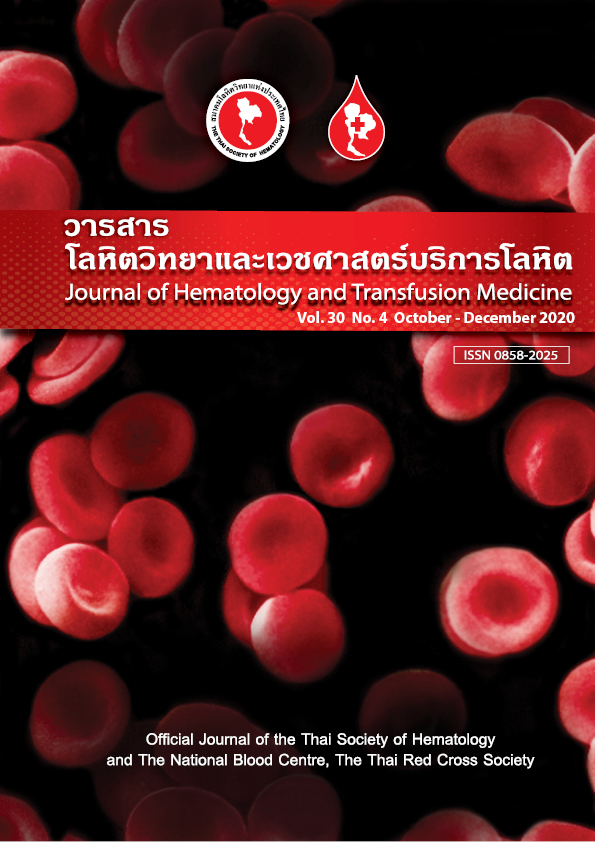การตรวจสอบความถูกต้องของคะแนนประจำเดือน (menstruation score) ในการจำแนกภาวะขาดธาตุเหล็ก
การตรวจสอบความถูกต้องของการใช้คะแนนประจำเดือน
คำสำคัญ:
ภาวะขาดธาตุเหล็ก, คะแนนประจำเดือนบทคัดย่อ
ความเป็นมา ภาวะขาดธาตุเหล็กเป็นภาวะทีพบบ่อยในผู้หญิงที ่ มีประจำเดือนมามาก การศึกษาก่อนหน้านี้มีการคำนวณคะแนนประจำเดือนจาก 2 คำถาม คือ ใช้ผ้าอนามัยตั้งแต่ 5 ผืน/วัน และมีเลือดชุ่มเต็มผืนหรือมีลิ่มเลือด (ใช่หรือไม่)
วัตถุประสงค์ เพื่อตรวจสอบความสามารถในการจำแนกภาวะขาดธาตุเหล็กของคะแนนประจำเดือน
วิธีการ เป็นการศึกษาแบบ cross-sectional ที่โรงพยาบาลในจังหวัดอุดรธานี และจังหวัดข้างเคียง ศึกษาในบุคลากรเพศหญิงที่ตรวจสุขภาพพบ ฮีโมโกลบิน < 12 g/dL และ MCV < 80 fL ผู้เข้าร่วมทำแบบสอบถาม รับประทานยาธาตุเหล็กนาน 3 เดือน และตรวจเลือดซ้ำ วิเคราะห์ผลโดยหาค่าความสามารถในการจำแนกภาวะขาดธาตุเหล็กของคะแนนประจำเดือน (AuROC) ความไว ความจำเพาะ และโอกาสเป็นภาวะขาดธาตุเหล็ก
ผลการศึกษา ในผู้ป่วย 130 ราย อายุเฉลีย 36.7 ปี คะแนนประจำเดือนมี AuROC เท่ากับ 0.71 (95%CI: 0.62-0.79) ที่จุดตัด 2 คะแนนมีความไว 54.5% ความจำเพาะ 80% หากนำค่าความกว้างของการกระจายขนาดเม็ดเลือดแดง (RDW) มาใช้ร่วมด้วยจะเพิ่ม AuROC เป็น 0.79 (95%CI: 0.71-0.87) อย่างมีนัยสำคัญทางสถิติ (p-value < 0.001)
สรุป คะแนนประจำเดือนมีความสามารถในการจำแนกภาวะขาดธาตุเหล็ก ในระดับทียอมรับได้ เหมาะกับการนำไปใช้เป็นแนวทางในการดูแลรักษาเบื้องต้น ในสถานที่ที่่ มีการตรวจสุขภาพ ทั้งนี้การนำค่า RDW มาใช้ร่วมด้วยสามารถเพิ่มความแม่นยำในการวินิจฉัยได้อย่างมีนัยสำคัญ
Downloads
เอกสารอ้างอิง
Pasricha SR, Drakesmith H, Black J, Hipgrave D, Biggs BA. Control of iron deficiency anemia in low- and middle-income countries. Blood. 2013;121:2607-17.
De Andrade Cairo RC, Rodrigues Silva L, Carneiro Bustani N, Ferreira Marques CD. Iron deficiency anemia in adolescents; a literature review. Nutr Hosp. 2014;29:1240-9.
Alton I. Iron deficiency anemia. Guidelines for adolescent nutrition services; 2005:101-8.
Brittenhan GM. Disorders of iron metabolism: iron deficiency and iron overload. In: Hoffman R, Benz EJ, Shattil SJ, et al., eds. Hematology basic principles and practice. 5th. Philadelphia: Churchill livingstone; 2009. p.453-74.
Miller JL. Iron Deficiency Anemia: A Common and Curable Disease. Cold Spring Harb Perspect Med. 2013; Jul 1;3(7). Pii: a011866. Doi:10.1101/cshperspect.a011866.
Stoltzfus RJ. Iron deficiency: global prevalence and consequences. Food Nutr Bull. 2003;24(4 Suppl):S99-103.
Pongudom S. Prevalence and Risk Factors of Iron Deficiency Anemia amongst Female Health Care Workers in Udonthani Hospital. J Hematol Transfus Med. 2016;26:35-4



